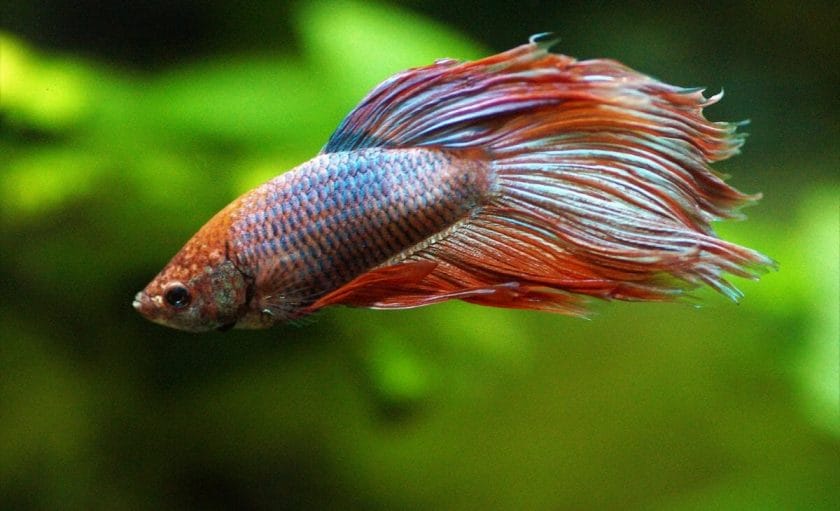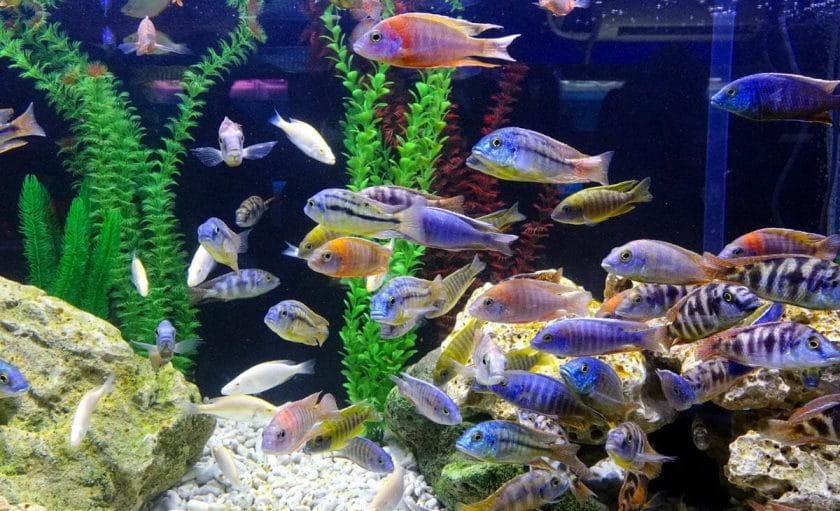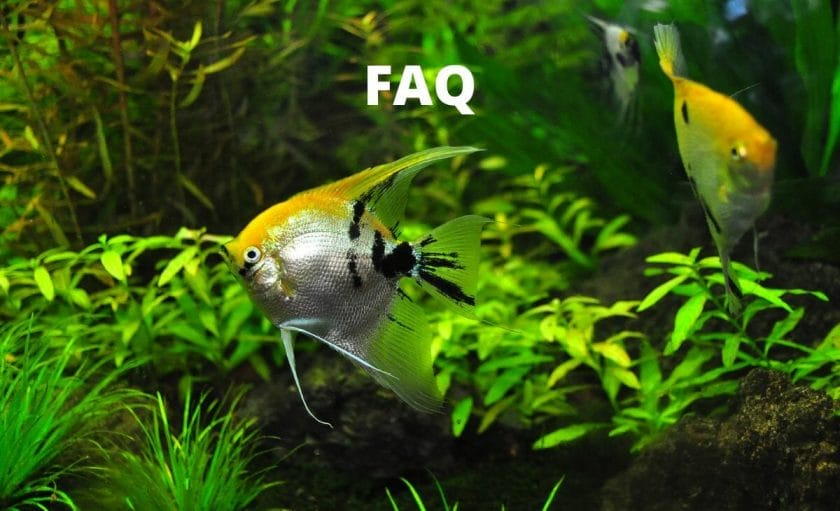Are you unsure of how often you should clean your fish tank?
Well, you’re in the right place; keep reading to find out!
A fish tank should be partially cleaned once a week or bi-weekly. Additionally, once a month a fish tank should undergo a complete and thorough clean.
Now that you know when to clean it, you need to know how.
Keep scrolling to discover easy and simple tank cleaning techniques.

Table of Contents
What Factors Affect How Often You Should Clean Your Tank?

A lot of things can affect how frequently you need to clean your tank, and distinguishing these can help you decide what the optimal cleaning schedule is for your tank.
Number of Fish in the Aquarium
The first thing to consider is the number of fish in your tank. Ammonia and nitrates are produced by fish waste. Both of these are extremely toxic to fish and, at high concentrations, can be fatal.
The more fish in the tank, the more toxic waste is produced, and the more often it needs to be cleaned. The recommended fish-to-tank size ratio is 1 inch of fish per every 1 gallon of water.
The Size of the Filter
Filter size is another important factor. If your filter’s capacity isn’t suitable for your tank size, then it won’t clean as efficiently.
The most efficient filter for your tank will have a flow rate of 6 times the volume of your tank or more.
The best filters are ones that contain chemical, biological, and mechanical filter media. You can get filters that focus solely on one. However, having all three in one filter is optimal.
External filters are preferred over internal ones as they have more cleaning power. They’re bigger and can hold much more media. They can also handle a larger fish population than internal filters.
Live Aquarium Plants
Live plants can help remove a lot of the harmful contaminants in your tank. They can remove ammonia, nitrates, carbon dioxide, and any decaying matter that may be in the tank.
They certainly can’t remove all of these, but they can aid in filtration.
If you have live plants in your aquarium, your tank will probably stay clean for longer. And you may not have to clean as often.
How Much Light Does the Fish Tank Get
Lastly, light exposure. Too much light exposure in your tank can cause more algae growth. Aquarium light or sunlight exposure should be controlled on a regular basis to avoid excess algae growth.
Sunlight exposure grows algae more rapidly.
Generally, 10 hours of light a day is sufficient. But make sure you research what your specific type of fish can handle and the needs of any live plants you may have.
How To Decide How Often You Should Clean Your Tank

Ultimately, your tank cleaning frequency depends on how soon it gets dirty.
One of the most important reasons you clean your tank is to maintain water safety.
Over time, harmful toxins build up in the water. Once these toxins reach a certain level, your fish can get sick and die.
That’s why it’s important to know exactly how long it takes for your fish tank to reach these levels. Testing your water is a good way to find this out.
You’ll want to test your water to discern how many nitrates your tank produces each week. Nitrates are the main thing to look out for, as this is what builds up from fish waste.
Nitrate levels in your tank should always stay below 40 ppm (parts per million) to ensure the health of your fish.
You’ll want to measure the nitrate levels in your fish tank every week for at least three weeks in a row. Each week, write down the nitrate level.
At the end, you can compare nitrate levels from week to week to figure out how many nitrates your tank increases by every week.
Keep in mind that small water changes are preferable on a regular basis, as larger water changes can stress your fish. Usually, 25% water changes are sufficient.
For example, if your tank produces 10 ppm nitrates every week, you should do a 25% water change once a week.
A Step-By-Step Guide To Measure Nitrate Levels In Your Fish Tank Using The API Master Test Kit
Using an API master Test kit you can easily measure the nitrate levels in your tank.
Besides, you can also measure pH, nitrite, and ammonia levels in your tank using this test kit.
If you don’t already have the API test kit, here’s the link to buy from Amazon.
- Fill up the provided test tube with your fish tank water to the 5 ml line.
- Add 10 drops of liquid from Bottle #1, which is provided in the kit. Then, with the cap on, slowly invert the tube a couple of times.
- Shake the provided Bottle #2 for 30 seconds before adding 10 drops of it to the test tube.
- With the cap on, shake the test tube for 1 minute.
- Now let it rest for 5 minutes.
- After 5 minutes, you’ll see the resulting color of the liquid. Compare this color to the chart provided in the kit. This will show you the current nitrate level in your tank.
How To Clean Your Fish Tank

Regular tank management and cleaning are important for the health of your fish. Harmful toxins and gases can build up in the tank over time, leading to detrimental side effects.
There are two kinds of cleaning to be aware of:
- Partial weekly clean
- Full monthly clean
A partial clean involves cleaning the bottom of the tank as well as a water change. You’ll want to do these once or twice a week.
For a full clean, you’ll want to clean all the other parts of the tank on top of that. But I’ll get into more detail about that below.
The materials you’ll need include:
If you have live plants, you may want to get scissors for pruning.
A Partial Clean
Below is a step-by-step guide to partially clean your tank on a weekly basis.
- Unplug all equipment, such as filters and heaters, while you’re cleaning.
- Use your gravel vacuum and the bucket to vacuum the bottom of the tank. Make sure to suck up any uneaten food or fish waste.
- Use the same vacuum and bucket to extract about 25% of your tank’s water into the bucket.
- Empty the dirty water and refill the bucket with water that matches the temperature of your tank.
- Add the proper dosage of dechlorinator for your tank’s size to the new water.
- Slowly refill your tank with the new water.
- Turn the equipment back on.
A Total Clean
Below is a step-by-step guide to a full monthly tank cleaning.
- Test your water with a water test kit. You’ll want to do this once a month to make sure your cleaning schedule is working well.
- Unplug all equipment, such as filters and heaters, while you’re cleaning.
- Remove any decorations/fake plants and scrub them clean with the toothbrush.
- Use the gravel vacuum and bucket to suck up any debris like fish waste or old fish food.
- Then use an algae scraper to clean the walls of the tank from any buildup.
- Using a scissor, prune any overgrown live plants.
- Use the vacuum and bucket to remove 25% of your tank’s water or as much needed.
- Clean out your filter. Filters can eventually get backed up with gunk, so a monthly refresh will help maintain its efficiency.
- Empty the dirty bucket of water and refill it with water that matches the temperature of your tank.
- Add the correct dechlorinator dosage for your tank size to the new water.
- Slowly refill your tank with the new water.
- Return all the decorations to their spots.
- Turn the equipment back on.
- Clean your aquarium light if needed.
After any water change, it’s best to leave your aquarium light off for a few hours. Fish get stressed when their environment changes, and leaving it dark can help reduce their stress levels.
Tips And Tricks To Keep Your Tank Clean

There isn’t much you can do to escape regular tank cleanings. But there are a few things you can do to stretch the time in between each clean.
Add a Clean-up Crew to Your Fish Tank
You can add some aquatic species to your tank that eat algae as a food source.
Some examples of clean-up crews include:
- Plecos
- Platys
- Snails
- Guppies
- Mollies
- Otocinclus Catfish
- Corydoras
- Shrimp
Don’t Overfeed Your Fish
Only feed fish what they’ll eat, so no food is left behind to decay. Leftover food can contribute to algae growth and filter backup.
Clean the Cleaning Tools
After every cleaning, disinfect your tools. Doing this regularly prevents bacteria from building up and going into your tank when you use the tools to clean it again.
Add Some Live Aquarium Plants to the Tank
Not only do live plants help keep your tank clean, but they also simulate a more natural and pleasing environment for your fish.
Make Sure You Aren’t Leaving Your Aquarium Light on All the Time
Too much light exposure promotes algae growth. Keep the light on for as long as your fish or live plants need it and no more.
Usually, this is around 10-12 hours, but you should research your fish and live plants to be sure.
FAQ

How Often Should You Change Your Fish Tank Water?
Depending on your tank’s weekly nitrate production, you should change your fish tank water once or twice a week.
You can use a water test kit to figure out weekly nitrate levels over a few weeks.
Alternatively, you can use a water test kit at the end of every week to see if your tank’s water needs to be changed. Nitrate levels should always remain under 40 ppm.
If your tank’s levels are close to 40 ppm, it’s time for a water change.
Does Having A Filter Or Not Affect How Often I Should Clean My Tank?
Yes, having a filter keeps your tank cleaner for longer. Filters remove harmful toxins and buildup in the water, such as nitrates and ammonia.
Without a filter, you will surely need to clean your tank more often.
How Often Should You Change The Gravel In Your Fish Tank?
You won’t ever need to replace the gravel if it’s properly maintained. Vacuum it during your regular tank cleanings to keep bad bacteria and microorganisms from growing on it.
Here are some signs it’s time to vacuum the gravel:
- Visible debris or particles in the gravel
- Little white worms in the gravel
- High ammonia levels when you test your water
Conclusion
In short, you should conduct regular tank cleanings once or twice a week, as well as a deep cleaning once a month to ensure the health of your fish.
Check your tank’s nitrate levels using the method above to find out how often you should clean it each month.
Happy fishkeeping!